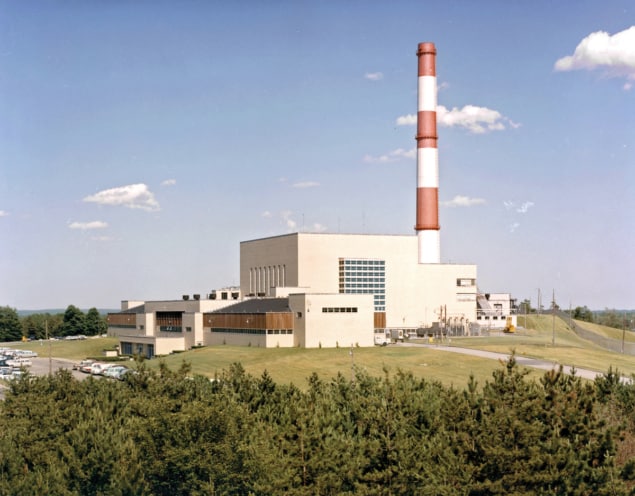Robert P Crease laments the disappearance of a landmark in US science history

For 70 years a red-and-white striped smokestack was the first thing visitors would see when arriving at Brookhaven National Laboratory on Long Island near New York. Painted that way to meet the requirements for navigational markers, the stack had been built for the Brookhaven Graphite Research Reactor (BGRR), which fired up in 1950. Along with the neighbouring brown reactor building, the stack formed part of the lab’s first logo and was the centrepiece of Brookhaven’s stock photos.
Measuring about 6 m in diameter and standing almost 100 m high, the stack was the tallest object in that part of Long Island. If you climbed the external ladder to the top, you saw water both to the north (Long Island Sound) and to the south (the Atlantic Ocean). The stack was designed to discharge the air that cooled the BGRR but had become slightly radioactive due to the presence of argon-41. This isotope has a half-life of 10.9 minutes so it decayed before reaching the ground.
Now, however, this monument to US science history is being demolished.
A world first
The BGRR was not just Brookhaven’s first major instrument but also the world’s first reactor built for the sole purpose of supporting basic research. Nuclear physicists used it to develop quantitative models of the nucleus, chemists to explore the structure of matter, and biologists to study tissue and to create radioisotopes for research and treatment. Engineers, meanwhile, came to the BGRR to study materials for submarines, ships, aircraft and spacecraft.
The BGRR was not just Brookhaven’s first major instrument but also the world’s first reactor built for the sole purpose of supporting basic research.
After the BGRR closed in 1968, the stack served as an air-exhaust pathway for the High Flux Beam Reactor, another basic research tool. But when that instrument was terminated in 1999, the stack became obsolete. Since then, apart from periodic inspections for structural integrity, it has stood there, alone and unused.
The BGRR’s project leader was the nuclear physicist Lyle Borst (1912–2002), who had been research supervisor at the X-10 reactor at Oak Ridge National Laboratory in Tennessee, which served the US military during the Second World War. Like X-10, the BGRR consisted of a huge, air-cooled cube of graphite moderator with natural uranium fuel.
Air flowed through a gap in the centre of the cube and was sucked into the fuel channels and a series of filters before passing into air ducts that carried it to a fan building, where powerful motors blew it up the stack. The turbulent air flow made a huge noise, and 5 m tall vertical steel panels were installed downstream of the fan house and upstream of the stack to dampen the sound by converting it to laminar flow.
While the stack was being built, Borst would treat visitors to a dramatic sonic shift by taking them into the stack and then to the fan house area, going from what engineers call an echoic chamber to an anechoic chamber. Standing inside the stack was like being in a giant organ pipe, ultra-reflective of every sound. “You’d clap your hands,” Borst told me when I spoke to him 30 years ago, “and this would go to the top of the stack, and bounce back own, and about 10 seconds later you’d hear a BANG, which was your clap.”
Sound-wise, the area near the silencers was the opposite. “If your partner were just a few feet away,” Borst said, “you couldn’t hear each other. The sound was all absorbed – there was no reflection, no echo, no nothing. It was just dead.” Sadly, silencers have been removed in preparation for the stack’s demolition, which is scheduled to take place in early November.
John Carter, director of communications at the US Department of Energy (DOE), told me that the stack is being demolished because of the “the ongoing cost and risks of inspection, maintenance, repair, and collection and disposal of contaminated rainwater”. Features like the stairway I climbed would need to be periodically surveyed and fixed. The DOE had contacted agencies involved in navigation and historical preservation, but none expressed a strong enough interest in the stack to warrant devoting the required resources.
The critical point
We’ve seen many public objects toppled this year. Throughout the US, statues of Confederate soldiers were removed, while in the UK statues of 17th-century slave traders were pulled down in both Bristol and London. These statues are coming down because they memorialize people whom we no longer honour.
The BGRR’s stack is not a monument to a cause we have ceased to honour, but its removal makes me ponder what science historians should keep.
The BGRR’s stack is not a monument to a cause we have ceased to honour, except perhaps to those who regard reactors as objectionable. But its removal makes me ponder what science historians should keep. Galileo’s telescopes and James Clerk Maxwell’s mechanical models are preserved in museums because they were literally instrumental to key discoveries. Other objects – like components of particle accelerators – end up in museums because the historic facilities to which they belonged are too big to preserve.

Brookhaven chosen to host major US nuclear physics facility
Occasionally, buildings that once housed important scientific research are saved, such as the Atomic Physics Observatory at the Carnegie Institute near Washington DC, which was built in 1938 to house a forefront Van de Graaff generator. That building has some architectural interest, being designed to resemble an astronomical observatory so nearby residents would not be frightened by the nuclear instrument inside.
The BGRR stack is in a different category. It is not part of the BGRR’s innards, but a monument by default as the last and most visible piece of the building that once contained it. Soon, however, it will be no more. I find that sad, because the stack is as much of a monument as Brookhaven has. Models, images, artifacts and a time-lapse photo series of the demolition will soon be all that remain.



